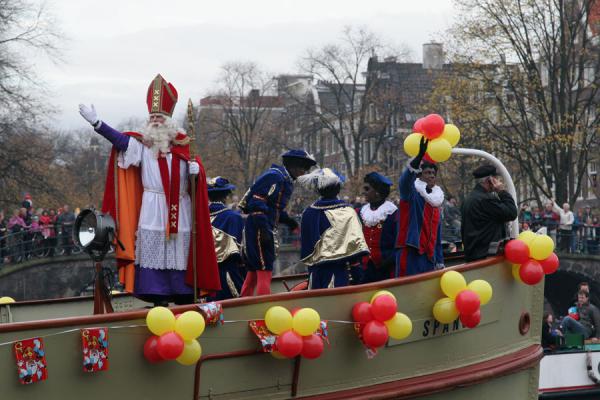December 06
St. Nicholas' Feastday
|
|
|
|
The Feast of Sinterklaas, or St. Nicholas, is an annual event which has been uniquely Dutch and Flemish for centuries. St. Nicholas' Feast Day is observed in most Roman Catholic countries primarily as a celebration for small children. In other countries he is the patron saint of sailors. According to one legend, as a young man Nicholas went to study in Alexandria and on one of his (sea) voyages from Myra to Alexandria he is said to have saved the life of a sailor who fell from the ship's rigging in a storm.
Few people are aware of how he Nicholas became the patron saint of children. According to legend, there was a major famine in the middle of the third century, shortly after Nicholas was appointed bishop. Through his family's wealth which he inherited, Nicholas was able to purchase food for his diocese. During one of his food distribution trips, Nicholas and his aides stopped at the home of a stranger where they were overwhelmed with the man's hospitality. and extraordinarily well-laid table that included meat which had practically disappeared during the famine.
When Nicholas sat down at the table, he realized that the meat was human flesh. Nicholas condemned his host and made him confess to a history of abducting local children and cannibalizing them. Nicholas was led to the man's cellar where he discovered three children that had been slaughtered for the evening meal, their remains salted down in a barrel. The legend recalls how Nicholas prayed over their remains and the children were restored to their full bodies and life.
This bizarre legend was recalled in Anthony Burgess' epic novel, Earthly Powers. The narrator, a character based on Somerset Maugham, discusses writing an opera based on St. Nicholas' life:
| "You see, I said, "you could have the legend of the resurrection of the three young men in a pickle barrel does as kind of a highly stylized prologue. And then the realism for the real story. The first of the adopted sons tries to turn Nicholas's house into a brothel, and Nicholas yields to the temptations of the flesh. After that he flagellates himself and gets himself holy for the Council of Nicea in order to denounce the Arian heresy." |
The opera was not a hit.
This legend was not featured in
the film
Nicholas of Myra: The
Story of St. Nicholas (2008)
In the Netherlands, Saint Nicholas eve is the
primary occasion for gift-giving. On December 5 when Saint Nicholas arrives
in The Netherlands by steamboat, children put their shoes in front of the
chimneys. Sometimes the shoes are filled with carrots or some hay for St.
Nicholas's horse. On the next morning they will find a small present in
their shoe, ranging from a bag of chocolate coins to a bag of marbles or
some other small toy. There was also that tradition that if a child was bad
that year, all that would be left in his or her shoes was coal. The filling
of children's shoes with presents is also a tradition throughout Germany.
Austria, and Hungary. The tradition was carried out in my Austro-Hungarian
family when I was a child. I clearly remember leaving my shoes out on St.
Nicholas eve and waking up in the morning with my shows filled with walnuts
and little candies wrapped in cellophane. There was also that tradition that
if a child was bad that year, all that would be left in his or her shoes was
coal.
One of that traditional Dutch foods prepared on St. Nicholas's feastday is a spiced butter cookies called speculaas. The cookies are have some image or figure (often from circle of traditional stories about St. Nicholas or of children) stamped on the front side before baking; the back side is flat. The cookies are then glued together with almonds paste so they resemble human Oreos, The name of the cookie comes from the Latin speculum meaning mirror and refers to the mirror images of the double cookie. They could also be an appropriate gift for a gynecologist. Some of the more lazy bakers also prepare single speculaas cookies for while they should find an alternate name since the concept of mirror in the name is lost.
Speculaas
 |
 |
 |
 |
Special Equipment Speculaas molds. These are very common in Europe. In the US, they can be ordered from House on the Hill, Inc., 650 West Grand Avenue, Unit 110 Elmhurst, IL 60126 .Toll Free: 877-279-4455 (U.S. only) |
|
1 cup unsalted butter;
softened |
2 tsp cinnamon 1 tsp nutmeg 1 tsp ground cloves 1/2 tsp ginger 1/8 tsp salt 1 cup chopped almonds almond paste |
| Instructions |
|
|
Makes about 18 cookies |
© 2012 Gordon Nary
